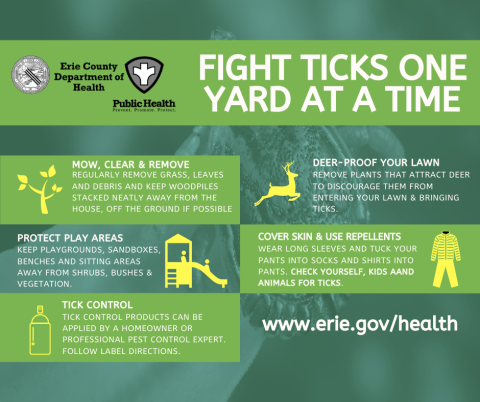Featured News - Current News - Archived News - News Categories
With warmer weather, Erie County Department of Health gives advice for preventing tick bites
By the Erie County Department of Health
Ticks are hardy creatures, and their tiny size can make them hard to find on skin – that goes for humans and for pets. Why do ticks get such a bad reputation? A tick bite can transmit bacteria that can cause severe illness. The most commonly mentioned tick-borne illness, Lyme disease, can cause flu-like symptoms days or weeks after the bite occurs. Other tick-borne illnesses have been reported in New York state; as tick populations expand to warmer, more inviting areas, they can bring other diseases with them.
As winter cold turns to spring warmth, the Erie County Department of Health (ECDOH) wants to highlight the need to prevent tick bites and reduce the risks for tick-borne illnesses.
“There are actions that you can take this spring, summer and fall to make your yard less friendly for ticks,” Commissioner of Health Dr. Gale Burstein said. “And every time you or your pets go outside, there are practical steps for you to prevent bites, check for ticks on skin and safely remove them if you have one attached.”
Fight Ticks One Yard at a Time
•Mow, clear and remove: Regularly remove grass, leaves and debris and keep woodpiles stacked neatly away from the house, off the ground if possible.
•Deer-proof your Lawn: Remove plants that attract deer to discourage them from entering your lawn and bringing ticks.
•Protect play areas: Keep playgrounds, sandboxes, benches and sitting areas away from shrubs, buses and vegetation.
•Cover skin and use repellents: Wear long sleeves and tuck your pants into your socks and shirts into pants. Check yourself, kids and animals for ticks after going outside.
•Tick control: Tick control can be applied by a homeowner or professional pest control expert; follow label directions.
When You Are Outside
√ Avoid direct contact with ticks.
√ Avoid wooded and brushy areas with high grass and leaf litter.
√ Walk in the center of trails: stay on cleared trails when walking or hiking, and avoid the edge habitat where ticks are likely to be.
√ Repel ticks on exposed skin with repellent that contains 20% or more DEET, picaridin or IR3535. Do not use on children younger than 2 months. Use according to instructions on the label.
√ Treat clothing, socks, shoes, boots, and camping gear with products that contain permethrin; do not use this on skin. It can remain protective through several washings. Pretreated clothing is available and may be protective longer.
√ Wear a long-sleeved shirt and long, light-colored pants tucked into socks or closed-toed shoes. Talk to your veterinarian about effective tick control options.
Find and Remove Ticks from Skin
√ Bathe or shower as soon as possible after coming indoors (preferably within two hours) to wash off and more easily find ticks that are crawling on you.
√ Conduct a full-body tick check using a hand-held or full-length mirror to view all parts of your body upon return from tick-infested areas. Parents should check their children for ticks under the arms, in and around the ears, inside the belly button, behind the knees, between the legs, around the waist, and especially in their hair.
√ Examine gear and pets. Ticks can ride into the home on clothing and pets, then attach to a person later, so carefully examine pets, coats, and day packs.
√ Tumble dry clothes in a dryer on high heat for 10 minutes to kill ticks on dry clothing after you come indoors. If the clothes are damp, additional time may be needed. If the clothes require washing first, hot water is recommended. Cold and medium temperature water will not kill ticks effectively. If the clothes cannot be washed in hot water, tumble dry on low heat for 90 minutes or high heat for 60 minutes. The clothes should be warm and completely dry.

For more:
√ ECDOH – ticks and Lyme disease: https://www3.erie.gov/envhealth/rabies-ratsrodents-vectors-arboviruses-and-related-information#ticks
√ New York State Department of Health, Lyme disease & tick bite prevention: https://www.health.ny.gov/publications/2813
√ NYSDOH-tick repellent: “Dress to Repel”: https://www.health.ny.gov/environmental/pests/dress_to_repel.htm
√ Centers for Disease Control and Prevention – Lyme disease: https://www.cdc.gov/lyme/
√ Environmental Protection Agency, select proper insect repellant: https://www.epa.gov/insect-repellents





























